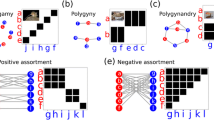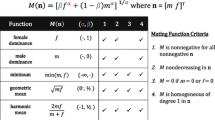Abstract
Measures of sexual dimorphism have been used extensively to predict the social organization and ecology of animal and human populations. There is, however, no universally accepted measure of phenotypic differences between the sexes. Most indices of sexual dimorphism fail to incorporate all of the information contained in a random data set. In an attempt to have a better alternative, an index is proposed to measure sexual dimorphism in populations that are distributed according to a probabilistic mixture model with two normal components. The index calculates the overlap between two functions that represent the contribution of each sex in the mixture. In order to assess such an index, sample means, variances and sizes of each sex are needed. As a consequence, the sample information used is greater than that used by other indices that take intrasexual variability into account. By evaluating some examples, our proposed index appears to be a more realistic measure of sexual dimorphism than other measures currently used.
Similar content being viewed by others
References
Alexander, R. D., J. L. Hoogland, R. D. Howard, K. M. Noonan and P. W. Sherman (1979). Sexual dimorphism and breeding systems in pinnipeds, ungulates, primates and humans, in Evolutionary Biology and Human Social Behavior: An Anthropological Perspective, N. A. Chagnon and W. Irons (Eds), Scituate, MA: Duxbury Press, pp. 402–435.
Bennett, K. A. (1981). On the expression of sex dimorphism. Am. J. Phys. Anthropol. 56, 59–61.
Borgognini Tarli, S. M. and E. Repetto (1986). Methodological considerations on the study of sexual dimorphism in past human populations. Hum. Evol. 1, 51–56.
Chakraborty, R. and P. P. Majumder (1982). On Bennett’s measure of sex dimorphism. Am. J. Phys. Anthropol. 59, 295–298.
Clutton-Brock, T. H. (1985). Size, sexual dimorphism and polygamy in primates, in Size and Scaling in Primate Biology, W. L. Jungers (Ed.), New York: Plenum Press, pp. 51–60.
Cope, D. A. (1993). Measures of dental variation as indicators of multiple taxa in samples of sympatric Cercopithecus species, in Species, Species Concepts, and Primate Evolution, W. H. Kimbel and L. B. Martin (Eds), New York: Plenum, pp. 211–237.
Davis, S. J. M. (1987). The Archaeology of Animals, New Haven: Yale University Press.
Dong, Z. (1997). Mixture analysis and its preliminary application in archaeology. J. Archeol. Sci. 24, 141–161.
Fleagle, J. G., R. F. Kay and E. L. Simons (1980). Sexual dimorphism in early anthropoids. Nature 287, 328–330.
Gilks, W. R., S. Richardson and D. J. Spiegelhalter (1996). Markov Chain Monte Carlo in Practice, London: Chapman and Hall.
Godfrey, L. R., S. K. Lyon and M. R. Sutherland (1993). Sexual dimorphism in large-bodied primates: The case of the subfossil lemurs. Am. J. Phys. Anthropol. 90, 315–334.
Gonda, K. (1959). On the sexual differences in the dimensions of the human teeth. J. Anthropol. Soc. Nippon. 67, 47–59.
Greene, D. L. (1989). Comparison of t-tests for differences in sexual dimorphism between populations. Am J. Phys. Anthropol. 79, 121–125.
Hathaway, R. J. (1985). A constrained EM algorithm for univariate normal mixtures. J. Stat. Comput. Simul. 23, 211–230.
Inman, H. F. and E. L. Bradley, Jr. (1989). The overlapping coefficient as a measure of agreement between probability distributions and point estimation of the overlap of two normal densities. Commun. Stat.-Theory Methods 18, 3851–3874.
Josephson, S. C., K. E. Juell and A. R. Rogers (1996). Estimating sexual dimorphism by method-of-moments. Am. J. Phys. Anthropol. 100, 191–206.
Kay, R. F. (1982). Sivapithecus simonsi a new species of Miocene hominoid, with comments on the phylogenetic status of Ramapithecinae. Int. J. Primatol. 3, 113–173.
Kelley, J. (1993). Taxonomic implications of sexual dimorphism in Lufengpithecus, in Species, Species Concepts, and Primate Evolution, W. H. Kimbel and L. B. Martin (Eds), New York: Plenum, pp. 429–458.
Klein, R. G. and K. Cruze-Uribe (1983). The Analysis of Animal Bones from Archaeological Sites, Chicago, IL: University of Chicago Press.
Leutenegger, W. and J. Cheverud (1982). Correlates of sexual dimorphism in primates: ecological and size variables. Int. J. Primatol. 3, 387–402.
Lovich, J. E. and J. W. Gibbons (1992). A review of techniques for quantifying sexual size dimorphism. Growth Dev. Ageing 56, 269–281.
Marini, E., W. Racugno and S. M. Borgognini Tarli (1999). Univariate estimates of sexual dimorphism: the effects of intrasexual variability. Am. J. Phys. Anthropol. 109, 501–508.
McLachlan, G. J. and K. E. Basford (1988). Mixture Models, Inference and applications to clustering, New York: Marcel Dekker Inc.
Meindl, R. S., C. O. Lovejoy, R. P. Mensforth and L. D. Carlos (1985). Accuracy and direction of error in the sexing of the skeleton: implications for paleodemography. Am. J. Phys. Anthropol. 68, 79–85.
Oxnard, C. E. (1987). Fossils, Teeth and Sex: New Perspective in Human Evolution, Seattle, WA: University of Washington Press.
Plavcan, J. M. (1994). Comparison of four simple methods for estimating sexual dimorphism in fossils. Am. J. Phys. Anthropol. 94, 465–476.
Plavcan, J. M. and C. P. van Shaick (1992). Intrasexual competition and canine dimorphism in anthropoid primates. Am. J. Phys. Anthropol. 87, 461–477.
Speth, J. D. (1983). Bison Kills and Bone Counts: Decision Making by Ancient Hunters, Chicago, IL: University of Chicago Press.
Yamada, E. (1932). The anthropological study of the Japanese teeth. J. Nippon. Dental Ass. 25, 15–46.
Author information
Authors and Affiliations
Corresponding author
Rights and permissions
About this article
Cite this article
Ipiña, S.L., Durand, A.I. A measure of sexual dimorphism in populations which are univariate normal mixtures. Bull. Math. Biol. 62, 925–941 (2000). https://doi.org/10.1006/bulm.2000.0185
Received:
Accepted:
Issue Date:
DOI: https://doi.org/10.1006/bulm.2000.0185




